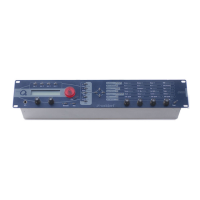Sound Parameters – Filter Section
Waldorf microQ User´s Manual 74
Filter Section
The most commonly used controls of the filters can be found in the parameter matrix.
The following picture of the microQ’s parameter matrix shows the Filter section:
Cutoff Keytrack Resonance Drive Env Velocity Type Panning
Filters
12
Filter section
Selecting and Editing Filters
Before you make any edits to the filters, you must select for editing either Filter 1, Filter 2, or both.
This can be done by pressing the left or right navigation button when the Filter section is selected.
Push the buttons until both Filter LED light up. The two LED of the Filter section indicate which filter
is selected for editing.
If both filters are selected for editing, moving any control will alter the setting of the corresponding
parameter for Filter 1 and Filter 2. Please note that all edits are relative. Therefore, the relationship of
the parameters will be retained. E.g. the display may look like this when turning the Cutoff knob:
[F1 Cutoff 80]
[F2 Cutoff 93]
In the given example, turning the Cutoff control two steps clockwise will result in the following:
[F1 Cutoff 82]
[F2 Cutoff 95]
If the value range of one parameter is reached, e.g by turning Cutoff clockwise until 127 is set for
Filter 1, the relationship is no longer retained. In this case, the cutoff of Filter 1 will keep its maximum
value while Filter 2’s cutoff is still increased by turning the knob.
The scenario is different when you move the Type knob. If both filters are selected for editing
and Type is altered, the same filter type is assigned to Filter 1 and Filter 2. This takes place
because altering selection parameters relatively does not make any sense.
Filter Parameter Controls
Cutoff 0…127
Controls the cutoff frequency for the low pass and high pass filter types, the center frequency for the
band pass and notch filter types, and the delay length of the comb filter types.
• When a low pass is selected via the Type parameter, all frequencies above the cutoff
frequency are damped.
• When a high pass type is selected, all frequencies below the cutoff frequency are damped.
• When a band pass type is selected, only frequencies near the cutoff setting will be passed
through.
• When a notch type is selected, the frequencies near the cutoff frequency are damped.
• When a comb type is selected, the frequencies near the cutoff frequency are emphasized
(comb+) or attenuated (comb-).

